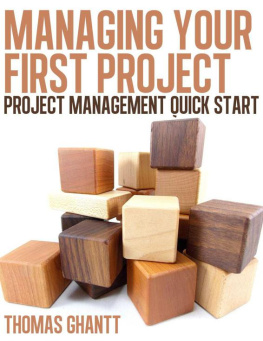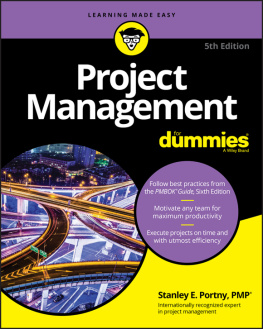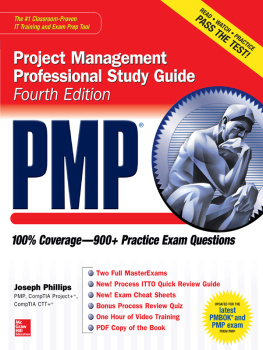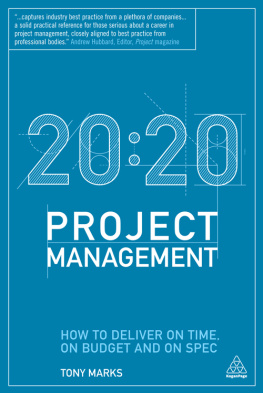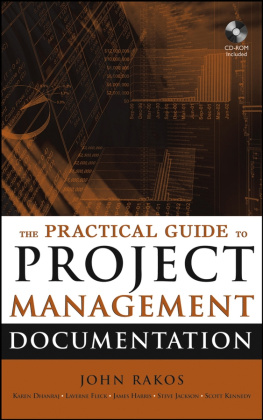Managing Your FirstProject
Project ManagementQuick Start
ThomasGhantt, PMP
PUBLISHED BY:
Plumbline Publishing Group
Copyright 2012
www.ThomasGhantt.us
ALL RIGHTS RESERVED. This book contains material protectedunder International and Federal Copyright Laws and Treaties. Any unauthorizedreprint or use of this material is prohibited. No part of this book may bereproduced or transmitted in any form or by any means, electronic ormechanical, including photocopying, recording, or by any information storageand retrieval system without express written permission from the author /publisher.
____________________________________________
Table of contents
This bookprovides an introduction to the project management steps which should beapplied to most projects. It is broken into two parts. Part one provides asummary of the key project management topics and can be used as a reference atanytime. Part two provides a basic step-by-step approach to applying these stepsto any project.
You willfind throughout this book a common sense and straightforward approach tomanaging your project. Many successful project managers have learned these samesteps on their own or after spending hours in expensive courses. Many wishedthey had a concise guide from the very beginning.
Over theyears as study of project management has grown in popularity and so has theexplosion of information, courses and confusion. In an attempt to make projectmanagement approachable and useful, there are now more guides, books, coursesand websites than most people could absorb in a lifetime. While this is usefulfor researching specific advice for a type of project, it can becomeoverwhelming to someone just starting out managing their first few projects.
This bookhas been written by a veteran project manager who has managed extremely largeprojects involving millions of dollars to very small projects which took just afew days to complete. The process you will learn has been used, refined andproven time over time. You will also learn that very little new information hasbeen generated in project management theory in many years. While many differentapproaches to project management now exist, most are based on the same basicprinciples already established. The process you will learn is not new, nor isit intended to be. What is new is having a book designed to guide you throughwhat is important to project management.
Your goalupon finishing this book will be to apply what youve learned to your projectsfor two outcomes. First, you need to complete your projects successfully andsecondly, you need to complete your project as efficiently as possible. Manypeople expend a tremendous amount of energy to complete their projects and walkaway from the experience discouraged and frustrated. Apply this advice and youwill complete your project successfully by following a proven process used onthousands of projects around the world.
Thematerial given to you can be applied to any type of project but our focus willbe on smaller projects which most people find they are managing. Your ownsituation might be similar to this. Many people are managing projects everydaybut do not consider themselves to be project managers. In fact, most peopleprobably fit that definition. And that is where this book will help youtremendously. You see, you do not need to be called a project manager to bemanaging a project, nor do you need to be called a project manager to apply thestraightforward guidance in this book to your projects.
If youare reading this book looking for the latest research into resource levelingusing optimized genetic algorithms, or building a Monte Carlo simulator in MSExcel, this book is not for you. If you read that last sentence and asked,What they heck is that?, then you are in the right spot.
Duringthe course of learning project management you are welcome to refer to www.ThomasGhantt.us for additional projectmanagement guides and templates you can use.
Part 1 Introduction to project management
What is Project Management?
Projectmanagement is the systematic application of tools, techniques and knowledge tohelp you achieve your projects objectives. Each project, no matter how smallis a dynamic, or constantly changing, system. The combination of multiplepeople doing work over a period time results in a growing list of things thatcan go wrong or go well. Project management is the science and art of ensuringthat your project goes well by arming you with the tools and knowledge neededfor your projects administration. What you learn in this book will betterequip you to reduce the undesirable things on your project and promote thosewhich can make your life on the project much better.
Contraryto what you might experience, have heard, or even been told by others, projectmanagement is not a complex science or art held in reserve for megacorporations building space stations or massive tunnels under Boston. Whilelarge, complex projects may require more people aligned to project managementactivities and usually require more advanced tools to be applied, the coreproject management toolbox is the same. If we peel away the details from thesemega projects and the smaller ones many of us manage daily, the administrationis generally not that different.
You mightwonder why? The reason is simple. A project is defined as a temporary,unique endeavor undertaken to achieve some objective or goal. It can last froma day to years but will eventually come to an end. You see, the definitionhas nothing to do with the size, budget or complexity of the project.Therefore, the core tools developed over the past several decades apply toorganizing a church bake sale to building the next space station.
Examples of small projects:
Eagle ScoutProject
Church bakesale
Annual Garagesale
Coordinatinga family reunion
Annual fundraiser
Replacing theoffice computers
Relocating adentist office across town
Build a newwebsite
There are four simple rules toalways remember when thinking about any project:
Rule 1 - Your project exists to producesomething which we will call the deliverables these can be products,services, training, food, etc. Your efforts on the project should always befocused on completing these deliverables.
Rule 2 - To produce those deliverablesyou will need to rely on both people and/or machines. Both will be your allyand your enemy so just accept that and always keep everyone, including yourselffocused on the reason youre doing the project in the first place. See Rule 1.
Rule 3 - Your project will haverestrictions in how long it can take and how much it can cost. We will callthese constraints and managing these is your job as project manager. You willlikely have little say in neither how much time the project has nor its budget.
Rule 4 Accept that bad things willhappen. Your project will face an untold number of unplanned and usually badevents. Prior to happening we will call these risks. Managing these is your jobas project manager. The more prepared you are the better your project willhandle them. Planning and managing your project, along with developing trustwithin the project team and communication will effect how these impact yourproject.
HowMuch Project Management do you Need?
Where alot of people get into trouble with project management, and maybe you fall intothis category. Learning just how much is needed and when certain tools or stepsshould be applied can be confusing to figure out. The reason is mostprofessional project managers and consults really (and I mean really) love allthe fancy, technical, and complex tools that can be used. In their exuberancefor all that is project management they leave a horrid trail ofmisinformation, confusion, frustration and fear of how to effectively apply theright level of project management to your project.
Next page
